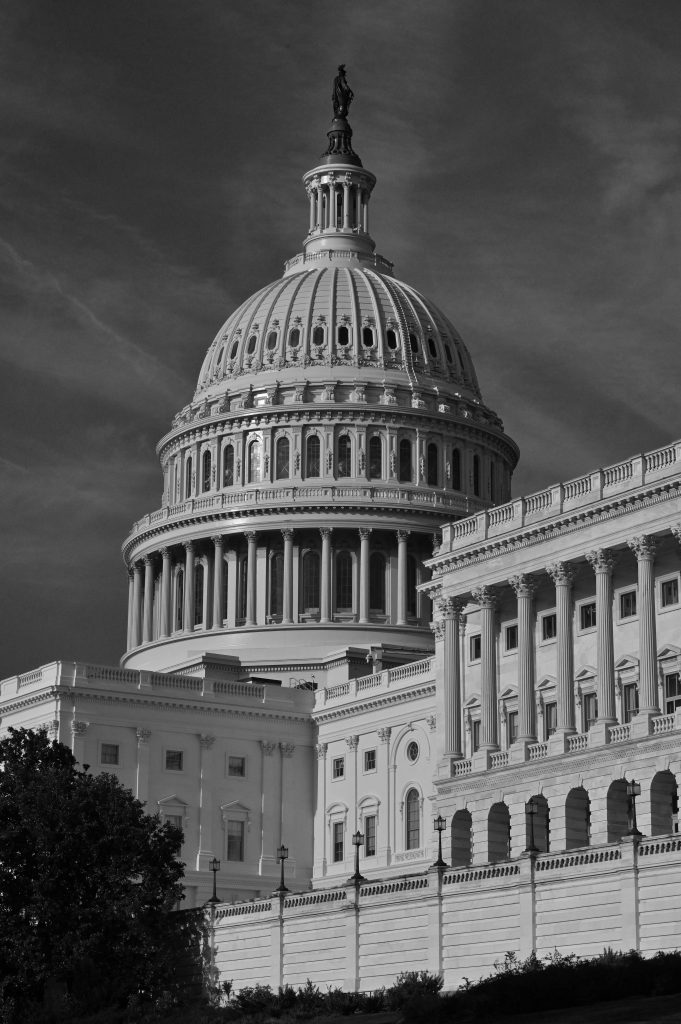A Two Trillion Dollar Idea: How Minting a Coin Would Avoid Potential Economic Catastrophe.
A Two trillion dollar Idea: How Minting a Coin Would Avoid Potential Economic Catastrophe
By Alexander Rudolph*
Question: When is a two trillion-dollar coin the answer to a nation’s fiscal problems? Answer: When the likely alternative is economic catastrophe, and the opportunity presents itself as an immediate and affable solution to the problem at hand.
Normally that question and answer would sound like the sum total of a bad joke, but we live in a time when it may be the basis for the soundest fiscal policy to avoid a potential economic disaster. While the idea of minting a coin worth two trillion dollars may sound facially absurd, once the contemporary criticisms of the congressional debt ceiling are considered alongside the underlying congressional intent behind its implementation, it becomes clear that the law no longer serves the original purpose that it was meant to. Because the federal government should not risk a potential default in order to remain in compliance with a law that no longer serves its original purpose, the most prudent fiscal policy decision the Biden Administration could take to avoid a potential default would be to direct the Secretary of the Treasury to mint such an absurdly valuable coin and deposit it into the Federal Reserve. That fiscal policy decision would lower the national debt to well below the congressional limit, and effectively eliminate the possibility of the government defaulting on its debt.
On September 28th, 2021, Senate Republicans successfully blocked a bill that was intended to fund the Federal government, despite repeated warnings from Treasury Secretary Janet Yellen about the economic calamity that a potential breach of the debt ceiling would create for the country.[1] Senate Minority Leader Mitch McConnell has steadfastly maintained that he does not intend to compromise and authorize any further increase to the debt ceiling during the current legislative session,[2] which would put the United States in a position where it will default on its outstanding debts if the ceiling is not raised by December 3rd of this year.[3] This battle is nothing new, as similar standoffs occurred as recently as 2011 and again in 2013, when Republican lawmakers wanted to stymie the Obama Administration’s policy agenda. As a result, in 2011 the United States lost its pristine AAA credit rating for the first time in the nation’s history, due to a perceived increase to the “political risk” intrinsic to U.S. debt.[4]
But how did it come to this? Despite this recently recurring political trend, the debt ceiling itself was not conceived to be, and generally has not historically been used as, an opportunity for such political brinksmanship. To the contrary, the concept of a Congressional limitation on the total amount of outstanding federal debt was originally created in the Second Liberty Bonds Act of 1917 as a more efficient alternative to having Congress authorize every individual debt that was issued by the federal government.[5]
Thus, in its early days the main function of the debt ceiling was to promote more efficient congressional discussion on the issues of the nation’s debt.[6] Although it was not a subject of partisan contention at its inception, the debt ceiling gradually came to be used by members of both parties as a means to position themselves as being “serious” about balancing the national budget.[7] At the same time however, those opposed to increasing the debt ceiling never truly considered the possibility of allowing a national default.[8]
Despite its sensible origins, contemporary political obstinacy on the issue of financing the nation’s financial obligations has called into question the very wisdom of having an established national debt ceiling to begin with. Only a few other countries have such a limitation, and of those the debt limit is so high that it effectively cannot ever be reached.[9] While the initial legislative intent behind its creation may have been to encourage bipartisan cooperation on the development of national economic policy, in recent practice it has been more aptly described as a “kind of apocalyptic Groundhog Day in American life,” and critics have begun to point out that the logic behind the debt ceiling is intrinsically nonsensical and potentially even unconstitutional.[10]
When the debt ceiling is considered along with the other spending powers granted to Congress, it is easy to see why the policy is criticized. Most laws passed by Congress include funding provisions that pay for their implementation. Because Congress is the constitutional entity responsible for approving spending, laws that have been passed by Congress have implicitly had their related spending already approved, even if the funding is not fully mentioned in the text of the law itself.[11] But the debt ceiling essentially acts as a barrier in this process, as it can prevent the Treasury from following its constitutional directive to pay for Congressional spending that has already been approved.[12] This policy would be sensible if Congress was willing and able to consider the national debt in the context of individual pieces of legislation that still required funding to go into effect. However, contemporary rhetoric on the issue often appears more preoccupied with vague narratives about governmental fiscal responsibility and political reprisal than anything else.[13]
If the underlying legislative intent behind the debt ceiling is not being respected by Congress, then why should the Executive Branch similarly respect that policy and allow a national default to be triggered if that limit is reached? The common-sense answer seems to be that the Executive Branch should not be held hostage to that limitation, and the issuance of a two trillion-dollar coin would free it from that burden.
The Omnibus Consolidated Appropriations Act of 1997, in part empowers the Treasury Secretary to print platinum coins of any denomination for any reason.[14] Although the idea was originally intended to bolster government funding by pandering to domestic coin collectors; the plain language of the law gives the Treasury Secretary absolute discretion in terms of pricing, issuing, and disseminating any platinum coins that she chooses to mint. If a coin worth a few trillion dollars was then minted, the President could then direct the Chair of the Federal Reserve to accept said coin as payment for outstanding U.S. bonds.[15] The acceptance of those funds would directly lower the outstanding national debt, preventing the debt ceiling from being reached and thereby stave off triggering any default.
While minting a two trillion-dollar coin to lower the national debt may sound like the Treasury is proverbially ‘cooking its own books’ to avoid crossing the debt ceiling threshold, is that really so bad? Many experts seem to believe that keeping the debt ceiling in place would be worse, since as long as it exists the potential of a government default also exists, and the consequences of a default would be catastrophically harmful to the country.[16]
More recently, contemporary debt ceiling critics have begun to argue that it would be unconstitutional in a few distinct ways for the President and the Treasury Secretary to allow the United States to stop payments on its outstanding debt once the debt limit is reached or passed.[17] It is not entirely clear that even if the President were to just direct the Treasury Secretary to simply ignore the debt ceiling, that anyone would have legal standing to challenge her decision to do so.[18] But simply because a purely legalistic solution to a potential default might exist does not make it the ideal solution. Any legal challenge to the mechanics of the debt ceiling runs the risk of igniting a legal battle that could still result in default, which is an unnecessary risk when the law that authorizes the minting of a trillion-dollar coin is clear and incontrovertible.
Critics of the trillion-dollar coin argue that this novel solution could have its own unforeseeable impacts on the economy. The fact the government would in effect be printing more of its own currency to pay for its own debts has led many to speculate that minting this trillion-dollar currency would result in serious inflation impacting the value of the U.S. dollar. However, that criticism is largely speculative, and economists have long been disputed the idea that Quantitative Easing policies like this necessarily result in an increase to the rate of inflation in general.[19] Indeed, the simplest method the Federal Reserve could use to avoid causing inflation would be to sterilize the government’s spending of the coin by selling other assets from its balance sheet on a dollar-for-dollar basis, in which case the effect on the monetary base of the U.S. dollar would be projected to be net to zero.[20] To put it in simpler terms, because the government owes itself money, it can print more money to pay that debt that it owes itself without letting that currency into circulation and impacting the wider economy.[21] When the debt ceiling issue is considered alongside these facts, one must ask if it still serves any beneficial purpose. If the professional consensus is that the debt ceiling limitation itself is nonsensical, self-contradictory, and potentially unconstitutional, then why not take advantage of an existing legal loophole to avoid continually flirting with economic catastrophe? Because the idea sounds silly? That might have been why the Obama Administration rejected it, but that Administration had a more moderate Congress to work with, and the Biden Administration has been told by its Republican opponents that they cannot expect that same luxury this time around.[22] The trillion-dollar coin proposal may be an absurd solution, but it is an absurd solution to an equally absurd problem. If embracing absurdity can bring financial stability, then it would be absurdly irresponsible for the Biden Administration not to do so.
* J.D. Candidate, Class of 2022, Arizona State University Sandra Day O’Connor College of Law.
[1] Jeff Stein, U.S. default this fall would cost 6 million jobs, wipe out $15 trillion in wealth, study says, Washington Post (Sept. 21, 2021), https://www.washingtonpost.com/us-policy/2021/09/21/debt-ceiling-recession-/.
[2] Joseph Zeballos-Roig, Treasury Secretary Yellen says she wants to get rid of the debt ceiling as McConnell threatens another default standoff in 2 months, Business Insider (Oct. 11, 2021), https://www.businessinsider.com/yellen-debt-ceiling-congress-mcconnell-gop-biden-default-2021-10.
[3] Emily Cochrane, Republicans Block Government Funding, Refusing to Lift Debt Limit, N.Y. Times (Oct. 6, 2021), https://www.nytimes.com/2021/09/27/us/politics/republicans-block-government-funding-bill-debt-limit.html.
[4] John Ditrexie, US Loses AAA Rating at S&P on Concerns Debt Cuts Deficit, Bloomberg (Aug. 6, 2011), https://www.bloomberg.com/news/articles/2011-08-06/u-s-credit-rating-cut-by-s-p-for-first-time-on-deficit-reduction-accord.
[5] CRS. Rep No. RL31967, at 3 (2015). (That law changed the overall congressional perspective regarding issues concerning the national debt away from paying for individual pieces of legislation by incurring new debt and embraced the concept that Congress should prevent the government from exceeding a certain total of outstanding debt that Congress had already determined would be too much).
[6] Linda Kowalcky & Lance T. LeLoup, Congress and the Politics of Statutory Debt Limitation, 53 Public Administration Rev. 14, 16 (1993), https://themonkeycage.org/wp-content/uploads/2011/07/debt-ceiling-leloup-1993.pdf. The debt ceiling used to be the central piece of legislation that enabled congressional debate and hearings to be held on issues involving the national budget, however following the passage of the Budget and Impoundment Act of 1974, the Congressional Budget Office would absorb that responsibility.
[7] Dylan Matthews, How Joe Biden Could End the Debt Ceiling — All By Himself, Vox (Sept. 28, 2021), https://www.vox.com/policy-and-politics/22684328/us-debt-ceiling-government-shutdown-biden-democrats. (As far back as John F. Kennedy and Lyndon B. Johnson’s presidencies, House Republicans were overwhelmingly voting against their opponents’ debt ceiling hikes (Senate Republicans were more prudent). But until the Obama administration, most votes against raising the limit were cheap talk.)
[8] Id. (Voting against an increase allowed politicians (including first-term Sen. Barack Obama) to posture as serious about balancing the budget, but the ultimate passage of the measure was never in jeopardy.)
[9] Tom Risen, Why Do Only US and Denmark Have a Debt Ceiling?, US World & News Report (Oct. 11, 2013), https://www.usnews.com/news/articles/2013/10/11/why-do-only-us-and-denmark-have-a-debt-ceiling. (The United States is the only democracy in the OECD, other than Denmark and Poland, that has a self-imposed legal limit on the amount of debt that it can issue.)
[10] Matthews, supra note 7.
[11] CRS Rep. No. R43389, at 4, (2021). (That understanding that Congress will pay for all of the laws that it passes, is why prior to 1917 and the creation of the aggregate debt ceiling, Congress was required to direct the Treasury to either issue loans or other financial instruments in order to issue that debt during that same legislative session.)
[12] Because the debt ceiling is now assessed on an aggregate rather than an individual policy basis, the federal government often finds itself in a position where, for example, it passes a law that costs $10, authorizes provisions that pay for up to $8 of its costs via taxation, but then faces the separate but related issue of exceeding the national debt ceiling when it attempts to issue debt to recoup those costs.
[13] Jennifer Bendery, Mitch McConnell’s Bogus Argument for Refusing To Raise The Debt Limit, Huffington Post (Sept. 30, 2021), https://www.huffpost.com/entry/mitch-mcconnell-raise-debt limit_n_61547973e4b075408bd1ba9f.
[14] The Omnibus Consolidated Appropriations Act of 1997, H.R. 36101, 104th Cong § 5112 (k), (1997).
[15] Satoshi Kamabayashi, Toss a Coin: A Crackpot Idea to Circumvent America’s Debt Ceiling Gains Currency, The Economist (Jan 12, 2013), https://www.economist.com/finance-and-economics/2013/01/12/toss-a-coin.
[16] Wendy Edelberg &Louise Sheiner, How Worried Should We Be If the Debt Ceiling Isn’t lifted?, Brookings Institute (Sept. 28, 2021), https://www.brookings.edu/blog/up-front/2021/09/28/how-worried-should-we-be-if-the-debt-ceiling-isnt-lifted/.
[17] Neil H. Buchanan, Bargaining in the Shadow of the Debt Ceiling: When Negotiating over Spending and Tax Laws, Congress and the Press and the President Consider the Debt Ceiling a Dead Letter, George Washington University (2013), https://scholarship.law.gwu.edu/faculty_publications/323/.
[18] Jeffery Rosen, How Would the Supreme Court Rule on Obama Raising the Debt Ceiling Himself?, New Republic, (July 28, 2011), https://newrepublic.com/article/92884/supreme-court-obama-debt-ceiling
[19] Lowell R. Ricketts, Quantitative Easing Explained, Fed. Res. Bank of St. Louis (April, 2011), https://files.stlouisfed.org/files/htdocs/pageone-economics/uploads/newsletter/2011/201104.pdf
[20] Kamabayashi, supra note 15.. (The Federal Reserve could ensure that commercial banks do not lend out excess reserves in a few distinct ways, as long as the Federal Reserve pays interest on those bank’s reserves at the Fed, the return commercial banks would receive from them is greater than the banks could receive from alternative uses.)
[21] Dylan Matthews, The Trillion-dollar Coin Scheme, Explained By the Guy Who Invented It, Vox (Oct. 7, 2021), https://www.vox.com/22711346/trillion-dollar-coin-mintthecoin-debt-ceiling-beowulf. (The Federal Reserve is able to do this because around 35% of the outstanding debt that is accounted for in the debt ceiling limitation is already held by the Federal Reserve in the form of US Treasury bonds.)
[22] Ezra Klein, Treasury: We Won’t Mint a Platinum Coin to Sidestep the Debt Ceiling, Wash. Post (Jan. 12, 2013), https://www.washingtonpost.com/news/wonk/wp/2013/01/12/treasury-we-wont-mint-a-platinum-coin-to-sidestep-the-debt-ceiling/.
Related Posts

Return to the Gilded Age? Union Pacific, Norfolk Southern, and a Transcontinental Railroad

Who Regulates America? How State Laws are Shaping National Markets
